[Editor’s note: This is the fifth of an ongoing series that examines the rise of writing – and therefore reading – around the world. We will be looking at the major developments and forces that shaped the written languages we use today. Links to all previous posts are located at the end of this one.]
So far in this series we’ve looked at the beginnings of humans’ use of written language, both the Sumerians’ use of cuneiform, a syllabic representation of their oral language, and the Egyptians’ use of hieroglyphs, a consonant-only system for conveying both objects and ideas. How do we know about these languages and the cultures that developed them? Much of that information has come from a single object known as the Rosetta Stone, an ancient artifact that is, in its way, the ultimate dictionary and translation machine.
The Rosetta Stone is a partial piece of a larger stone created in 196 BCE that contains writing in two languages (Egyptian and Greek), and in three scripts (hieroglyphic, demotic, and Greek). The writing is an official message, called a decree, about Ptolemy V, the king who ruled from 204–181 BCE. The decree was copied on to large stone slabs called stelae, which were put in every temple in Egypt, and it says that the priests of a temple in Memphis, Egypt supported the king. The Rosetta Stone is only one of these copies, so it’s not particularly important in its own right. What is important, however, is that the decree is inscribed three times, in hieroglyphs (suitable for a priestly decree), demotic (the native Egyptian script meaning ‘language of the people’ and used for daily purposes), and Ancient Greek (the language of the region’s rulers and administration at the time –Greco-Macedonian following Alexander the Great’s conquest of Egypt).
Once the Romans conquered Egypt in 30 BCE, hieroglyphs fell into disuse and their meaning was lost, remaining a mystery for the next 1,800 years. In the late 1700s, Napoleon Bonaparte attempted to create his own great empire, and he campaigned in Egypt from 1798 to 1801 with the intention of dominating the East Mediterranean and removing the British stranglehold on India. While accounts of the exact discovery remain somewhat sketchy, the prevailing view is that soldiers in Napoleon’s army, trying to build an addition to a fort near the town of Rashid (Rosetta) in the Nile Delta, discovered the Stone by accident on July 15, 1799. It had apparently been built into an old wall then covered by the debris of time. Pierre-François Bouchard (1771–1822), the officer in charge, realized the importance of the discovery and brought it to the attention of the scientific community. When Napoleon was defeated, the Stone became British property under the terms of the Treaty of Alexandria (1801) and was shipped to England, arriving in Portsmouth in February 1802 where it has remained ever since.
As many scholars in the early years of the 19th century understood ancient Greek, this provided them with a starting point to decipher the other two texts. Thomas Young (1773–1829), an English physicist, was the first to show that some of the hieroglyphs wrote the sounds of a royal name, that of Ptolemy.

In this portion of the ancient Stone’s Greek section, you can make out Ptolemy’s name six lines down in the center of the text.
It was French scholar and Egyptologist Jean-François Champollion (1790–1832), though, who made the biggest breakthrough in the translation and became the first person in modern times to learn to read hieroglyphs. Champollion could read both Greek and Coptic, a descendent of ancient demotic. Examining the texts, he figured out what seven of the demotic signs were in Coptic, and, knowing how these signs were used in Coptic, he worked what they stood for in the ancient demotic. Then he began tracing these demotic signs back to hieroglyphic ones.
Other scholars noted that certain groups of hieroglyphs on the Rosetta Stone were surrounded by a carved oblong loop, called a cartouche; these separated the names of kings and queens from large bodies of text. Champollion understood enough of hieroglyphs at this point to confirm that the cartouches on the Rosetta Stone contained the name of one of the Greek rulers of Egypt, Ptolemy V, as Young had determined was present in the Greek section.

A portion of the Rosetta Stone’s hieroglyphic section with a cartouche that matches the ancient Greek spelling of Ptolemy
As Champollion examined more cartouches, he observed that some of the glyphs matched between the one found for Ptolemy’s name and the ones in the other cartouches. Champollion determined that these glyphs phonetically spelled out the names of certain Greek rulers of Egypt, and this led to the realization that the hieroglyphs contained an alphabet and a record of the sound of the Egyptian language. There were two categories of glyphs, phonograms (sound symbols) and ideograms (object or idea symbols); this knowledge helped him decipher additional hieroglyphs on Egyptian objects that had made their way to Europe. Champollion announced his discovery, which had been based on analysis of the Rosetta Stone and other texts, in a paper at the Academie des Inscriptions et Belles Lettres at Paris on Friday, September 27, 1822. The audience included his English rival Thomas Young. Work continued on hieroglyphic translation following Chapollion’s death.
Next up: The development of the Chinese writing system
References:
British Museum, (14 July 2017.) “Everything You Ever Wanted to Know about the Rosetta Stone.” Retrieved from https://blog.britishmuseum.org/everything-you-ever-wanted-to-know-about-the-rosetta-stone/
International World History Project (http://history-world.org/)
http://www.ancientegypt.co.uk/writing/rosetta.html
To read Part 1 (Sumerians), click here.
To read Part 2 (Egyptian hieroglyphs), click here.
To read Part 3A (Indo-European languages part 1), click here.
To read Part 3B (Indo-European languages part 2), click here.
